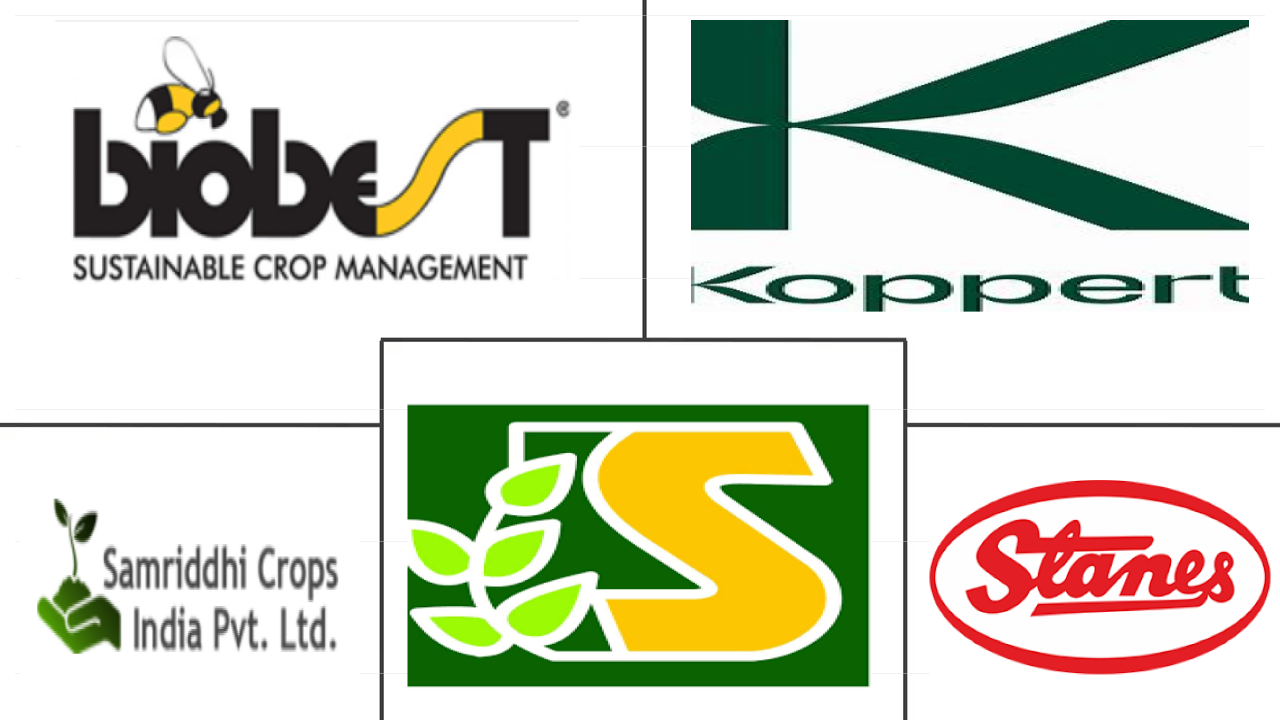Market Size of asia-pacific biocontrol agents Industry
|
|
Study Period | 2017 - 2029 |
|
|
Market Size (2024) | USD 2.51 Billion |
|
|
Market Size (2029) | USD 3.37 Billion |
|
|
Largest Share by Form | Macrobials |
|
|
CAGR (2024 - 2029) | 6.13 % |
|
|
Largest Share by Country | India |
Major Players |
||

|
||
|
*Disclaimer: Major Players sorted in no particular order |
Asia-Pacific Biocontrol Agents Market Analysis
The Asia-Pacific Biocontrol Agents Market size is estimated at 2.51 billion USD in 2024, and is expected to reach 3.37 billion USD by 2029, growing at a CAGR of 6.13% during the forecast period (2024-2029).
2.51 Billion
Market Size in 2024 (USD)
3.37 Billion
Market Size in 2029 (USD)
3.50 %
CAGR (2017-2023)
6.13 %
CAGR (2024-2029)
Largest by Form
99.97 %
value share, Macrobials, 2023
Predators, parasitoids, and entomopathogenic nematodes are the commonly used macrobials in the region. Predators dominated the macrobials market with a share of 87.1% in 2022.
Fastest by Form
6.18 %
Projected CAGR, Microbials, 2024-2029
The microbial biocontrol agents can easily be multiplied for commercial purposes in laboratories and have higher ease of application compared to macrobial biocontrol agents.
Largest by Crop Type
83.63 %
value share, Row Crops, 2023
The dominance of row crops in biocontrol market is mostly due to their extensive organic cultivation area, which in 2022 accounted for 67.5% of all organic area in the region.
Largest by Country
78.01 %
value share, India, 2023
The microbials dominated India's biocontrol agents market with a share of 60.1% in 2022. The most commercially exploited microbials are Beauvaria bassiania and Trichoderma.
Leading Market Player
2 %
market share, Koppert Biological Systems Inc., 2022

The company is involved in production of various Biological products which include natural pollinators, Biocontrol agents for pest and diseases, and biofertilizers.
- Predators dominated the macrobials segment with a market share of 90.6% in 2022. The dominance of the predators segment in the overall biocontrol agents market is mainly due to their ability to attack different life stages of pests and even different pest species, as they are more voracious feeders than other biocontrol agents.
- Many predatory arthropods, including lady beetles, lacewing larvae, and mites, are agile and ferocious hunters. They actively stalk their prey on the ground or in vegetation. Other hunters, such as dragonflies and robber flies, catch their prey in flight. In contrast, ambushers patiently sit and wait for mobile prey. Praying mantids, for example, are usually well camouflaged and use the element of surprise to nab their unsuspecting victims.
- The microbial biocontrol agents market accounted for 0.1% in the year 2022. The microbial biocontrol agents can easily be multiplied for commercial purposes in laboratories and have higher ease of application compared to macrobial biocontrol agents.
- Fungal biocontrol agents accounted for 31.0% of the microbial segment of the Asia-Pacific biocontrol agents market in 2022. The most commercially exploited fungal species as biocontrol agents are Beauvaria bassiania and Trichoderma viride. Beauvaria bassiania is a fungus that is used against a wide range of pests, and Trichoderma viride is used to control a wide range of plant diseases by paralyzing the harmful disease-causing fungi.
- Bacterial biocontrol agents accounted for 28.9% of the Asia-Pacific microbials market in 2022. Some of the most intensively studied are bacteria belonging to the genus Pseudomonas spp., Bacillus spp., and Streptomyces spp., which have already been registered as commercial products.
- The Asia-Pacific biocontrol agents market is growing rapidly, dominated by India, which held a market share of 51.0% in 2022. The microbial biocontrol agents segment accounted for 60.1% of the Asia-Pacific market in the same year. They are popular since they can be easily multiplied for commercial purposes in laboratories and have higher ease of application than macrobial biocontrol agents. The microbial segment is projected to witness a CAGR of 8.4% during the forecast period.
- The dominance of row crop cultivation in the region, accounting for about 67.5% of the total organic cultivation area in the Asia-Pacific region in 2022, led to them recording consumption of 82.7% of the market by value in the same year. Rice, cassava, corn, soybean, sugarcane, coconut, and rubber are major crops cultivated in the region.
- China holds the second-largest share in the Asia-Pacific biocontrol agents market, accounting for a share of 42.3% in 2022. The Chinese government's initiatives to decrease the overall use of chemical pesticides and development plans for local organic agriculture by municipal governments at all levels are helping boost the Chinese biological controls market. In addition, incentives have been introduced to encourage producers to switch to organic farming. These factors may further drive the biocontrol agents market in the country during the forecast period.
- The Asia-Pacific biocontrol agents market represents significant growth opportunities for businesses and investors. With the increasing demand for organic products and various government and non-government initiatives to promote organic farming, the Asia-Pacific biocontrol agents market is projected to witness a CAGR of 8.4% during the forecast period (2023-2029).
Asia-Pacific Biocontrol Agents Industry Segmentation
Macrobials, Microbials are covered as segments by Form. Cash Crops, Horticultural Crops, Row Crops are covered as segments by Crop Type. Australia, China, India, Indonesia, Japan, Philippines, Thailand, Vietnam are covered as segments by Country.
- Predators dominated the macrobials segment with a market share of 90.6% in 2022. The dominance of the predators segment in the overall biocontrol agents market is mainly due to their ability to attack different life stages of pests and even different pest species, as they are more voracious feeders than other biocontrol agents.
- Many predatory arthropods, including lady beetles, lacewing larvae, and mites, are agile and ferocious hunters. They actively stalk their prey on the ground or in vegetation. Other hunters, such as dragonflies and robber flies, catch their prey in flight. In contrast, ambushers patiently sit and wait for mobile prey. Praying mantids, for example, are usually well camouflaged and use the element of surprise to nab their unsuspecting victims.
- The microbial biocontrol agents market accounted for 0.1% in the year 2022. The microbial biocontrol agents can easily be multiplied for commercial purposes in laboratories and have higher ease of application compared to macrobial biocontrol agents.
- Fungal biocontrol agents accounted for 31.0% of the microbial segment of the Asia-Pacific biocontrol agents market in 2022. The most commercially exploited fungal species as biocontrol agents are Beauvaria bassiania and Trichoderma viride. Beauvaria bassiania is a fungus that is used against a wide range of pests, and Trichoderma viride is used to control a wide range of plant diseases by paralyzing the harmful disease-causing fungi.
- Bacterial biocontrol agents accounted for 28.9% of the Asia-Pacific microbials market in 2022. Some of the most intensively studied are bacteria belonging to the genus Pseudomonas spp., Bacillus spp., and Streptomyces spp., which have already been registered as commercial products.
| Form | |||||||
| |||||||
|
| Crop Type | |
| Cash Crops | |
| Horticultural Crops | |
| Row Crops |
| Country | |
| Australia | |
| China | |
| India | |
| Indonesia | |
| Japan | |
| Philippines | |
| Thailand | |
| Vietnam | |
| Rest of Asia-Pacific |
Asia-Pacific Biocontrol Agents Market Size Summary
The Asia-Pacific biocontrol agents market is experiencing significant growth, driven by the increasing demand for organic farming and the reduction of chemical pesticide use. This market is characterized by a diverse range of biocontrol agents, including predators, microbial, and fungal agents, with predators dominating the macrobials segment due to their effectiveness in controlling various pest species. The microbial segment, which includes bacterial and fungal agents, is particularly popular for its ease of application and commercial scalability. Countries like India and China are leading the market, with India holding a substantial market share and China benefiting from government initiatives promoting organic agriculture. The region's focus on organic farming is further supported by the large organic cultivation areas in countries such as China, India, Indonesia, and Australia, which are encouraging the adoption of biocontrol agents.
The market's expansion is also fueled by the growing consumer awareness and demand for organic products, which is reflected in the increasing per capita spending on organic goods, particularly in Australia and China. The Asia-Pacific region's organic market is fragmented, with a few major players dominating the biocontrol agents sector. Companies like Biobest Group NV and Koppert Biological Systems Inc. are key players, actively expanding their product offerings and market presence. The region's organic agricultural land is predominantly occupied by row crops, with significant areas dedicated to cash crops, driven by international demand for organic products. As consumer knowledge and income levels rise, the market for biocontrol agents and organic products in the Asia-Pacific region is expected to continue its upward trajectory, presenting lucrative opportunities for businesses and investors.
Asia-Pacific Biocontrol Agents Market Size - Table of Contents
-
1. MARKET SEGMENTATION (includes market size in Value in USD and Volume, Forecasts up to 2029 and analysis of growth prospects)
-
1.1 Form
-
1.1.1 Macrobials
-
1.1.1.1 By Organism
-
1.1.1.1.1 Entamopathogenic Nematodes
-
1.1.1.1.2 Parasitoids
-
1.1.1.1.3 Predators
-
-
-
1.1.2 Microbials
-
1.1.2.1 By Organism
-
1.1.2.1.1 Bacterial Biocontrol Agents
-
1.1.2.1.2 Fungal Biocontrol Agents
-
1.1.2.1.3 Other Microbials
-
-
-
-
1.2 Crop Type
-
1.2.1 Cash Crops
-
1.2.2 Horticultural Crops
-
1.2.3 Row Crops
-
-
1.3 Country
-
1.3.1 Australia
-
1.3.2 China
-
1.3.3 India
-
1.3.4 Indonesia
-
1.3.5 Japan
-
1.3.6 Philippines
-
1.3.7 Thailand
-
1.3.8 Vietnam
-
1.3.9 Rest of Asia-Pacific
-
-
Asia-Pacific Biocontrol Agents Market Size FAQs
How big is the Asia-Pacific Biocontrol Agents Market?
The Asia-Pacific Biocontrol Agents Market size is expected to reach USD 2.51 billion in 2024 and grow at a CAGR of 6.13% to reach USD 3.37 billion by 2029.
What is the current Asia-Pacific Biocontrol Agents Market size?
In 2024, the Asia-Pacific Biocontrol Agents Market size is expected to reach USD 2.51 billion.

